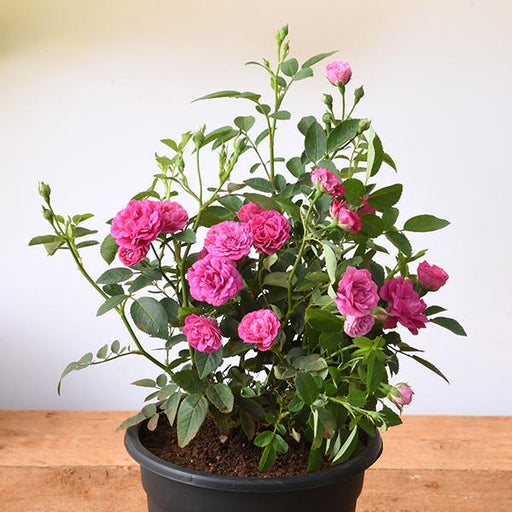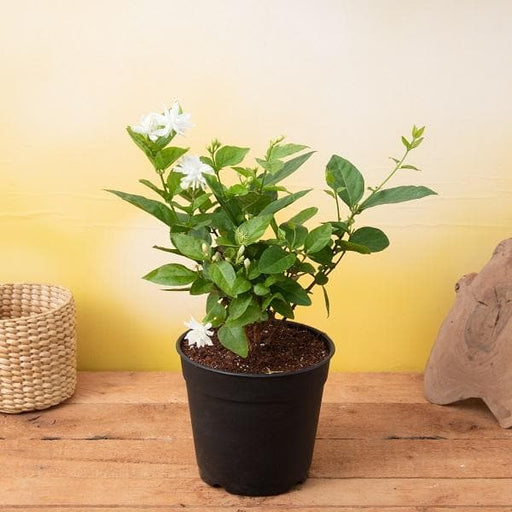
Buddleja asiatica - Plant
(MRP Inclusive of all taxes)
- Shipping ₹79 for entire order
- Dispatch in 7 days
- Country of origin: India

(MRP Inclusive of all taxes)
 Save 29%
Save 29%
Air Purifier Money Plant with Pot The Air Purifier Money Plant, also known as Pothos or Epipremnum aureum, is a stunning indoor plant that...
View full details
 Save up to 15%
Save up to 15%
Peace Lily, Spathiphyllum - Plant The Peace Lily, scientifically known as Spathiphyllum, is a stunning houseplant celebrated for its elegant white...
View full details
 Save 25%
Save 25%
Jasminum sambac, Mogra, Arabian Jasmine - Plant Jasminum sambac, commonly known as Mogra or Arabian Jasmine, is a fragrant flowering plant...
View full details
 Save 18%
Save 18%
Combo Constituents Includes the Parijat Tree (Night-Flowering Jasmine), a culturally significant plant with fragrant flowers. Description The Pari...
View full details
 Save 25%
Save 25%
Miniature Rose, Button Rose (Any Color) - Plant The Miniature Rose, also known as the Button Rose, is a charming and compact flowering plant that ...
View full details Save 25%
Save 25%
Damascus Rose, Scented Rose (Any Color) - Plant The Damascus Rose, also known as Rosa damascena, is a timeless symbol of beauty and romanc...
View full details
 Save 17%
Save 17%
Beautiful Fragrant Mogra, Arabian Jasmine Plant with Pot The Beautiful Fragrant Mogra, also known as Arabian Jasmine (Jasminum sambac), is...
View full details Save 15%
Save 15%
Pack of Vermicompost and Neem Cake for House Plants Transform your indoor garden with our premium Pack of Vermicompost and Neem Cake, spec...
View full details
Pack of Plant Growth and Flower Boosters Unlock the full potential of your garden with our Pack of Plant Growth and Flower Boosters! This ...
View full details Save 38%
Save 38%
Combo of Jeevamrut and Neem Raksha for Easy Growth and Protection of Houseplants Transform your indoor garden with our exclusive combo of ...
View full details Save 22%
Save 22%
Plant Nutrients Kit (Pack of 16) for a Healthy Garden Transform your garden into a lush paradise with our Plant Nutrients Kit, featuring 1...
View full details Save 16%
Save 16%
Combo of Top Plant Fertilizers Elevate your gardening game with our exclusive Combo of Top Plant Fertilizers, featuring two bags of premiu...
View full details Save 24%
Save 24%
Pack of 4 Additives to Make Soil Healthy and Nutrient Rich Transform your garden into a thriving ecosystem with our Pack of 4 Additives de...
View full details Save 30%
Save 30%
Transform your gardening experience with our premium Combo of Perlite and Vermiculite. This unique blend is designed to enhance soil aeration and ...
View full details Save 27%
Save 27%
Combo of 2 Vermicompost and Cocopeat - Enrich Your Soil Naturally! Transform your garden into a thriving ecosystem with our Combo of 2 Ver...
View full details
 Save 35%
Save 35%
Best 6 Plants for Perfect Indoor Garden Transform your living space into a lush oasis with our curated collection of the Best 6 Plants for a...
View full details
 Save up to 50%
Save up to 50%
Mini Succulent Garden Pack Transform your space with our Mini Succulent Garden Pack, featuring a delightful collection of 4 any variety beautiful s...
View full details
 Save 30%
Save 30%
5 Best Fragrant Plants Transform your garden or indoor space into a fragrant paradise with our curated selection of the 5 Best Fragrant Plants. Th...
View full details
 Save 24%
Save 24%
Set of 2 Bonsai Looking Grafted Adeniums Transform your indoor or outdoor space with our exquisite Set of 2 Bonsai Looking Grafted Adenium...
View full details Save 45%
Save 45%
Top 4 Die Hard Succulents Pack Transform your indoor or outdoor space with our Top 4 Die Hard Succulents Pack, featuring a curated selecti...
View full details
 Save 30%
Save 30%
5 Best Indoor Plants Pack Transform your living space into a lush oasis with our '5 Best Indoor Plants Pack.' This carefully curated collection fe...
View full details
 Save 25%
Save 25%
Set of 4 Evergreen Air Purifier Plant Pack Transform your indoor space into a lush, green oasis with our Set of 4 Evergreen Air Purifier Pla...
View full details| SrNo | Item Name |
|---|---|
| 1 | Buddleja asiatica - Plant |
Buddleja asiatica, commonly known as the Asian Butterfly Bush, is a stunning perennial shrub native to the mountainous regions of Asia. This fast-growing plant is celebrated for its fragrant, tubular flowers that attract a myriad of pollinators, including butterflies and bees. With its lush green foliage and vibrant blooms, Buddleja asiatica is an excellent choice for gardens, borders, and wildlife habitats.
This plant is not only visually appealing but also plays a crucial role in supporting local ecosystems. Its flowers are rich in nectar, making it a favorite among pollinators. Buddleja asiatica is also known for its adaptability to various soil types and climates, making it a resilient addition to any garden.
Buddleja asiatica boasts unique characteristics, including its ability to thrive in poor soil conditions and its drought resistance once established. The plant can grow up to 10 feet tall, providing a stunning vertical element to your landscape. Its long-lasting blooms can range from lavender to deep purple, creating a vibrant display throughout the summer months.
Buddleja asiatica contributes positively to the environment by providing essential habitats for pollinators and other wildlife. Its ability to thrive in less-than-ideal soil conditions makes it a sustainable choice for gardeners looking to enhance biodiversity. By planting Buddleja asiatica, you are not only beautifying your space but also supporting the ecosystem.
If you think caring for Buddleja asiatica is like babysitting a cactus, think again! This plant thrives on a little TLC, but don’t worry, it won’t demand a bedtime story. Just ensure it gets well-drained soil, a sunny spot, and occasional watering. It’s like the diva of the plant world—low maintenance but high on charm!
Why should you invite Buddleja asiatica to your garden party? Well, it’s not just a pretty face! This plant attracts butterflies and bees, making your garden the hottest spot in town for pollinators. Plus, it’s known for its air-purifying abilities, so you can breathe easy while enjoying its beauty. Talk about a win-win!
If you’re looking for a plant that grows faster than your neighbor’s gossip, Buddleja asiatica is your go-to! This beauty can reach impressive heights in just a few seasons, making it the overachiever of the garden. Just be prepared to keep up with its rapid growth—pruning might become your new hobby!
Want to multiply your Buddleja asiatica like rabbits? Propagation is the name of the game! You can easily take cuttings and watch them flourish into new plants. It’s like cloning your favorite plant without the sci-fi drama. Just remember, with great power comes great responsibility—don’t let them take over your garden!
Every plant has its enemies, and Buddleja asiatica is no exception. Aphids and spider mites might try to crash the party, but fear not! A little neem oil or insecticidal soap can send them packing. Think of it as your plant’s bouncer, keeping the riffraff out while letting the butterflies in.
Buddleja asiatica is a bit of a soil snob. It prefers well-drained, sandy loam that’s rich in organic matter. If your soil resembles a brick, it’s time for a makeover! Mix in some compost and watch your plant thrive. After all, even plants deserve a luxurious living environment!
This plant is a sun worshipper, soaking up rays like it’s on a tropical vacation. Buddleja asiatica thrives in full sun, so make sure to give it a prime spot in your garden. If it could wear sunglasses, it would! Just remember, too much shade is like a bad hair day for this beauty.
Get ready for a floral fiesta! Buddleja asiatica bursts into bloom during the summer, showcasing its vibrant flowers that attract all the right attention. It’s like the life of the party, drawing in butterflies and hummingbirds. Just be prepared for the compliments—your garden will be the talk of the town!
Looking for the perfect plant pals for Buddleja asiatica? Think of it as a matchmaking service for your garden! Pair it with other sun-loving perennials like lavender or salvia. Together, they’ll create a harmonious ecosystem that’s not only beautiful but also beneficial for pollinators. It’s a garden party waiting to happen!
Buddleja asiatica is like that friend who can handle any climate. It thrives in USDA hardiness zones 7 to 10, making it a versatile choice for many gardeners. Whether you’re in a sunny state or a slightly cooler area, this plant is ready to adapt and shine. Just don’t forget to check your zone before planting!
This plant isn’t just a pretty face; it’s a multitasker! Buddleja asiatica can be used for hedges, borders, or even as a focal point in your garden. Its fragrant flowers can also be used in floral arrangements, making it the ultimate garden MVP. Who knew a plant could be so talented?
Ready to elevate your garden game? Buddleja asiatica can be the star of your landscaping show! Use it as a backdrop for shorter plants or create a stunning border. Its vibrant blooms will add a splash of color and attract wildlife, turning your garden into a nature lover’s paradise. Get ready for the compliments!
Buddleja asiatica, also known as the Asian butterfly bush, is a charming shrub that attracts butterflies like a magnet. With its fragrant flowers and lush foliage, it’s the perfect addition to any garden. Just be prepared for a fluttering party of pollinators!
Caring for Buddleja asiatica is a breeze! Plant it in well-drained soil, give it full sun, and water it moderately. Prune it back in early spring to encourage bushy growth. Just remember, it thrives on neglect—so don’t overdo it!
Buddleja asiatica puts on its floral show from late spring to early fall. Its vibrant blooms will have your garden looking like a butterfly rave! Just sit back, relax, and enjoy the colorful spectacle as butterflies flock to the party.
While Buddleja asiatica is a delightful addition to gardens, it can be a bit of a party crasher in some areas. It’s best to check local guidelines, as it may outcompete native plants. Keep it in check, and let the butterflies enjoy responsibly!
Absolutely! Buddleja asiatica can thrive in pots, making it a perfect patio companion. Just ensure the pot has good drainage and provide enough sunlight. With a little love, you’ll have a portable butterfly haven right on your balcony!
Buddleja asiatica prefers well-drained soil that’s rich in organic matter. Think of it as a diva that doesn’t like soggy feet! A mix of loamy soil and compost will keep it happy and blooming like there’s no tomorrow.
Buddleja asiatica can reach heights of 3 to 6 feet, depending on its mood and growing conditions. It’s like the garden’s friendly giant, providing a lovely backdrop for smaller plants while attracting all the butterflies in the neighborhood!
Yes, Buddleja asiatica is quite the drought-tolerant superstar! Once established, it can handle dry spells like a champ. Just remember, it prefers a good drink during its early days, but after that, it’s ready to strut its stuff in the sun!
Buddleja asiatica is not the top choice for deer, making it a great option for gardens in deer-prone areas. They tend to prefer tastier treats, leaving your butterfly bush to flourish and attract all the fluttering friends instead!
Propagating Buddleja asiatica is as easy as pie! You can take softwood cuttings in late spring or early summer. Just dip them in rooting hormone, plant them in moist soil, and watch them grow into new butterfly-attracting beauties!
Buddleja asiatica is generally pest-resistant, but watch out for aphids and spider mites. If they crash the party, a gentle spray of water or insecticidal soap will send them packing. Keep your plant healthy, and it’ll fend off most unwanted guests!
While Buddleja asiatica prefers the great outdoors, you can try growing it indoors if you have a sunny spot. Just remember, it’s a social butterfly that loves fresh air, so take it outside whenever possible for a little garden mingle!